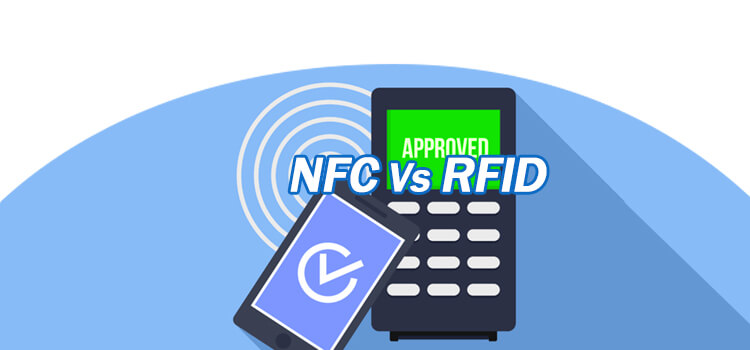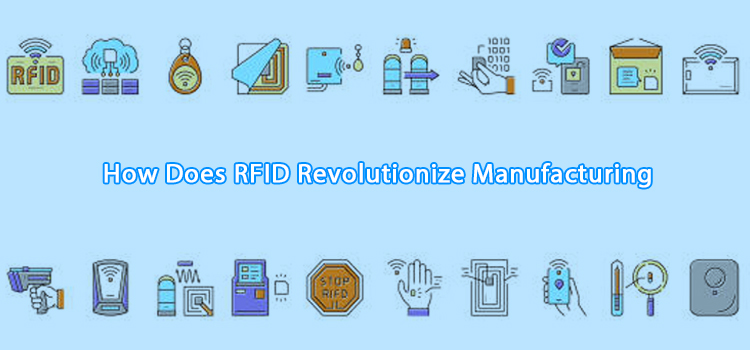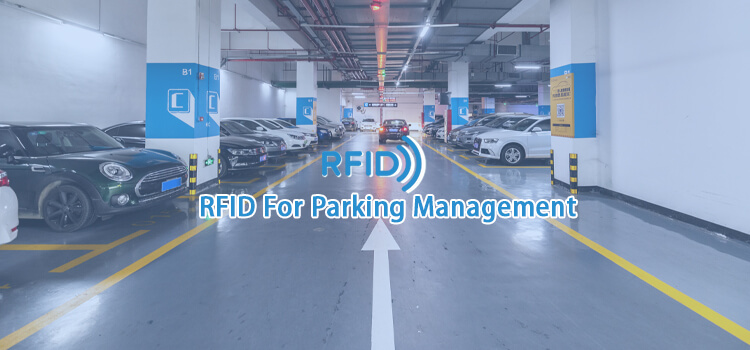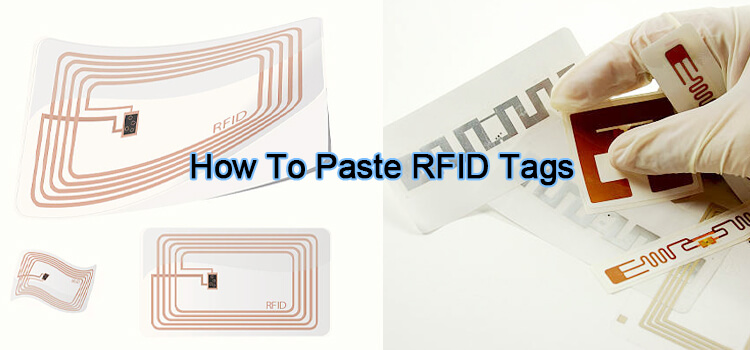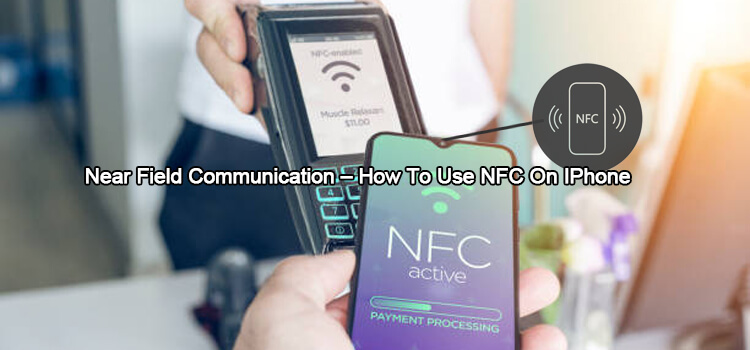Near Field Communication (NFC) and Radio Frequency Identification (RFID) are wireless communication technologies, but they work differently. NFC is a subset of RFID that operates at a shorter range and is used for more localized communication between two devices.
RFID can be used over a greater distance to communicate with multiple devices. RFID is also more commonly used for tracking while NFC is more common in making payments. Here’s a comprehensive NFC vs. RFID guide:
What is NFC?
Near Field Communication (NFC) is a technology that enables two devices to communicate wirelessly when they are near each other. NFC operates at a frequency of 13.56 MHz and can transfer data at speeds up to 424 Kbit/s.
Most Android and iOS smartphones include NFC support, and many devices that don’t include it can be enabled with NFC adapters.
NFC is commonly used for making payments with contactless credit cards or mobile payments services like Apple Pay and Android Pay.
Brief History of NFC Technology
NFC technology was developed in the early 2000s by Nokia, Philips, and Sony. The first NFC-enabled phone was the Nokia 6131 in 2006.
It works by communicating with an NFC tag, which is a small chip that can store data. NFC tags can be embedded in physical objects like stickers, key chains, and wristbands, or they can be integrated into digital content like websites and apps.
What are the Applications of NFC Technology?
NFC short-range communication is used in different applications such as:
- Contactless Payment
This is the most popular application of NFC. NFC-enabled smartphones can be used to make payments by waving them in front of a contactless reader. For example, Apple Pay and Google Pay are payment services that use NFC.
Besides convenience, these payment options are regulated by several NFC standards to guarantee security.
NFC can also be used in combination with other technologies, such as Bluetooth, to create a more secure payment system.
- Data Sharing
Another common application of NFC is data sharing between two devices. This can be done by tapping the devices together or by bringing them close to each other.
This can be useful for quickly sharing photos, contacts, and other files between devices.
NFC can also be used to initiate actions on one device based on a gesture or event on another device. For example, you could use NFC to automatically turn on your phone’s Bluetooth when you touch it to an NFC tag.
- Product Identification
NFC can also be used for product identification. You can achieve this by encoding product information, such as a barcode or QR code into an NFC tag.
When you scan the tag, the product information will be displayed.
This can be used to quickly and easily identify products.
- NFC and Access Control
NFC can also be used for access control. The NFC tag is encoded with access information, such as a username and password.
When the tag is scanned, the user will be authenticated and granted access to the restricted area.
- NFC-Enabled Hotel Keys
Some hotels are starting to use NFC-enabled hotel keys. These keys work just like traditional hotel keys, but they also include an NFC tag.
When the key is scanned by an NFC-enabled device, it will open the door and log the user into the hotel’s Wi-Fi network.
This allows guests to quickly and easily access their room and the hotel’s Wi-Fi network.
- Home Automation
NFC can also be used for home automation. This is done by encoding home automation commands, such as “turn on the lights,” into an NFC tag.
When the tag is scanned by an NFC-enabled device, the command will be executed.
This can be used to automate common tasks in your home.
What is RFID?
Radio Frequency Identification (RFID) is a technology that enables two devices to communicate wirelessly over a distance of up to 100 meters. RFID operates at frequencies of 125 kHz, 13.56 MHz, and 866 MHz and can transfer data at speeds up to 2 Mbit/s.
RFID is commonly used for tracking items and managing inventory. RFID tags can be embedded in objects or printed on labels.
Brief History of RFID Technology
RFID technology was first developed in the 1940s, but it didn’t become popular until the 1990s. One of the early adopters of RFID technology was Walmart, which began using it to track inventory in 2003.
Since then, RFID has become a popular tool for tracking items and managing inventory. It is also being used in a variety of other applications, such as contactless payments and access control.
How Does RFID Work?
Radio-frequency identification (RFID) is a technology that uses radio waves to communicate. It uses RFID tags and RFID readers to facilitate communication protocols.
The tag contains a microchip with an antenna that sends out a signal identifying the object and its unique serial number. RFID readers capture this signal and decode the data, which can then be used to track the object’s movement.
RFID technology has been used for years in automatic toll collection and animal identification. It has expanded in recent years to include retail inventory tracking, access control, and secure document tracking. RFID is also being used in conjunction with mobile devices to create “smart” cities that can manage energy usage, traffic flow, and other urban systems.
RFID tags come in a variety of shapes and sizes and can be embedded in objects, printed on labels, or attached to the skin. Some tags are powered by energy from the reader device, while others have their power source. Tags can also be read remotely or through contact with the object.
RFID Tags
There are three main types of RFID tags: passive, active, and semi-passive.
- Passive tags are the simplest type of tag. They contain no power supply and rely on the reader to provide power. Passive tags are typically used for short-range applications, such as tracking items in a store or managing inventory.
- Active tags contain a battery and can transmit data over longer distances than passive tags. They are typically used for long-range applications, such as asset tracking and contactless payments.
- Semi-passive tags are a hybrid of passive and active tags. They contain a battery that powers the tag for a short period. This allows the tag to transmit data over longer distances than passive tags. Semi-passive tags are typically used for long-range applications, such as asset tracking.
RFID Readers
There are three main types of RFID readers: portable, desktop, and fixed.
- Portable Readers. These are small, lightweight readers that can be easily carried around. They are typically used for personal tracking or inventory management.
- Desktop Readers. These are larger, heavier readers that are designed to be used in a fixed location. They are typically used for access control or inventory management.
- Fixed Readers. These are the largest and most powerful RFID readers. They are typically used for tracking large items or vehicles. They are located in a fixed location and cannot be easily moved.
What are the Applications of RFID Technology?
RFID technology has many applications, including:
- Asset Tracking
RFID is widely used to track assets. It is a more efficient and cost-effective alternative to barcodes.
RFID tags can be embedded in objects or printed on labels. When an RFID reader is passed over the tag, the tag’s unique ID is read and the information is transmitted to a computer or database.
This allows you to know the location and status of your assets. It reduces the chances of loss and theft.
- Retail Store Inventory Management.
RFID is also used to manage inventory in retail stores. RFID tags can be embedded in products or printed on labels. When an RFID reader is passed over the tag, the tag’s unique ID is read and the product information is transmitted to a computer or database.
This allows businesses to track the stock levels of their products and make sure they never run out.
- Product Authentication
RFID can also be used to authenticate products. RFID tags can be embedded in products or printed on labels. When an RFID reader is passed over the tag, the tag’s unique ID is read and the product information is transmitted to a computer or database.
- Traffic Control
RFID can also be used for traffic control. RFID tags can be embedded in license plates or printed on windshield stickers. When an RFID reader is passed over the tag, the tag’s unique ID is read and the information is transmitted to a computer or database.
This allows businesses to track the movements of their employees or customers.
- Animal Identification
RFID is also used for animal identification. RFID tags can be embedded in animals or printed on labels. When an RFID reader is passed over the tag, the tag’s unique ID is read and the animal information is transmitted to a computer or database.
- Passport Control
RFID is also used for passport control. RFID tags can be embedded in passports or printed on labels. When an RFID reader is passed over the tag, the tag’s unique ID is read and the passport information is transmitted to a computer or database.
Similarities between RFID and NFC
There are several similarities between RFID and NFC:
- Both technologies use radio waves to transmit data. Both technologies involve the use of electromagnetic waves to communicate between two devices.
- Use of Tags and Readers. Both technologies use tags and readers. Tags are small devices that contain information. On the other hand, readers are devices that read the information contained in tags.
Differences between RFID and NFC
Despite the similarities between RFID and NFC, there are several key differences between the two technologies:
- Range. RFID has a range of up to 100 meters, while NFC has a range of fewer than 10 centimeters. This means that RFID can be used to track objects from a distance, while NFC is best suited for close-range communication.
- Applications. The applications of RFID and NFC are different. RFID is mainly used for tracking and authentication, while NFC is used for contactless payments and communications.
- Cost. RFID tags are typically more expensive than NFC tags. This is because RFID technology has more applications than NFC technology. Also, RFID technology has a longer read range, making them ideal for object tracking.
Which Technology Is Better?
There is no clear answer as to which technology is better. NFC has the advantage of faster data transfer speeds, while RFID has the advantage of a longer range.
Additionally, NFC is more commonly used for making payments, while RFID is more commonly used for tracking items. Ultimately, it depends on the needs of the individual or business.
NFC technology has a wide range of applications, including contactless payments, person-to-person payments, P2P file transfers, ticketing, product identification, and home automation.
RFID technology is also widely used and has a variety of applications, including asset tracking, asset management, patient tracking, food tracking, animal identification, and inventory management.
Both NFC and RFID have their advantages and disadvantages, so it is important to understand the needs of the individual or business before deciding which technology to use.
NFC vs. RFID: How to Choose the Best Technology for Your Business
If you’re unsure which technology is right for your business, here are a few things to consider:
- What are the main purposes of the technology? NFC is primarily used for making payments and communications, while RFID is used for tracking and authentication.
- How large is the area where the technology will be used? NFC is best suited for close-range communication, while RFID can be used for communication over a greater distance.
- What is the data transmission speed requirement? NFC supports faster data transfer speeds than RFID.
- What is the security requirement? NFC is more secure than RFID.
- What is the budget? RFID tags are typically more expensive than NFC tags.
Once you have answered these questions, you can determine which technology is best for your business. If you still can’t decide, contact a trusted technology advisor for assistance.
Emerging Issues/ Future of RFID & NFC Technology
RFID technology is continuing to evolve, and new applications are being developed all the time.
For example, recent advances in near-field communication (NFC) technology have made it possible to use RFID tags as payment cards or for other transactions. NFC-enabled phones can also be used to read RFID tags without the need for a dedicated reader device.
As RFID technology becomes more common, there are growing concerns about the potential for privacy and security breaches. To address these concerns, the RFID industry is working on standards for data security.
Related Articles
- 6 NFC Forum Types You Need To Know
- A Guide About Different Types Of RFID Tags
- Learn All About What Is Nfc Tag
- 28 Cool Uses Of NFC Tags You Need To Know
- What Are RFID Standards?
- Everything You Need To Know About RFID Chip
- A Guide To Buying RFID Tags & Equipment
- What Is NFC Payment?
- NFC Vs. Bluetooth: What Is The Difference?

